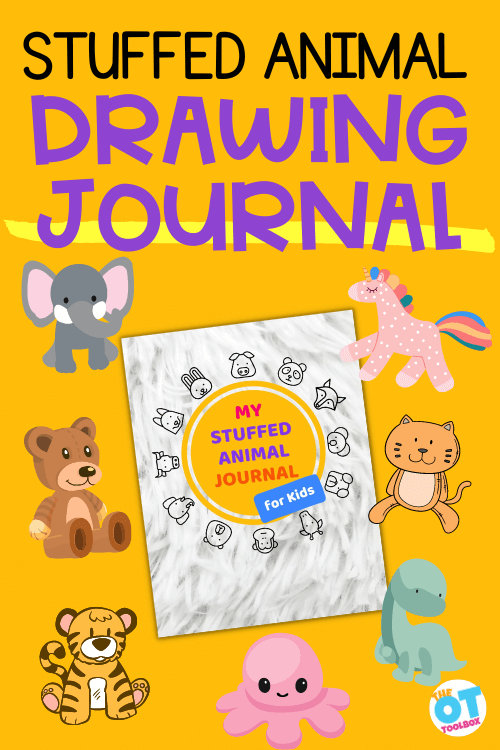We had the chance to check out a new resource over on Amazon…a drawing journal for kids to use with their favorite stuffed animals! When it comes to helping kids with handwriting needs, coming up with creative and engaging activities can significantly contribute to enhancing various skills. That’s where therapeutic journaling comes into play, using a favorite toy or stuffed animals.
We wanted to share the drawing journal as a tool to support a variety of skills!

Kids love this drawing journal!
Drawing Journal for Kids
The drawing journal, My Stuffed Animal Journal for Kids (Amazon affiliate link) is just that, a drawing journal with writing and drawing prompts for kids to use when writing about their favorite stuffed animals and soft toys.
We had a chance to draw and write about some of our favorite stuffed animals, and it was a hit. As an occupational therapist, I love the large drawing spaces on the page, and the bold writing lines for using line awareness in the writing prompts.
When using a motivating and meaningful writing prompt with kids (like asking them to write about their favorite stuffed animals!), there are many skills that you can target:
- Letter formation
- Line use
- Spacing between words and letters
- Pencil pressure
- Erasing skills
- Writing skills-forming thoughts and putting them onto paper
- Creativity
- Confidence
- Executive functioning skills
The drawing journal has a space for kids to draw a picture of what their stuffed animal looks like. This is such a fun drawing prompt for kids!
When children select a favorite stuffed animal or toy, the drawing prompt is meaningful and motivating. You can target a variety of skills with the drawing prompt section of the book:
- Pencil control
- Hand eye coordination
- Erasing skills
- Coloring
- Visual motor skills
Drawing Journal for Emotional Expression
The drawing journal offers kids a chance to express emotions and interests when it comes to their stuffed animal. The drawing journal prompts ask what each stuffed animal does at night.
Kids can write about every toy or stuffed animal they own and express their emotions through their stuffed animal journal.
Include prompts that prompt reflection on daily (nightly) experiences, feelings, and imaginative scenarios involving their plush toy companions.
Drawing Journal Prompts for Fine Motor Skills
As an occupational therapist, I love that the drawing journal prompts kids to draw and then write in several sections of the pages.
When kids draw, color, and write on each page, they can use a variety of drawing tools to improve fine motor skills:
- Pencils
- Colored pencils
- Markers
- Crayons
Highlight drawing prompts that target fine motor skills, aiding in the development of hand-eye coordination and pencil control. Emphasize the therapeutic value of these activities in occupational therapy sessions, supporting children in honing their motor skills through creative expression.
Stuffed Animals at Night
Kids love to wonder about the fun adventures their favorite toys and stuffed animals enjoy at night while the house is sleeping. It’s a fun and creative writing and drawing prompt that not only engages creativity but also serves as a tool to address executive functioning skills and narrative abilities like working memory, task completion, planning and prioritization.
Beyond the joy of documenting the nighttime adventures of a favorite stuffed animal, a drawing and writing prompt that asks about what a child’s favorite stuffed animals do at night provides a powerful therapeutic avenue for honing problem-solving, creative thinking, critical thinking, working memory, and cultivating a positive mindset.
You can even ask students to add more details to their stuffed animals’ nighttime adventures with challenges the toys have and ask the students to come up with solutions. This process of expanding the writing prompt helps children develop problem-solving skills, teaching them to approach difficulties with resilience and determination. This is a great critical thinking activity for kids!
Grab your copy of My Stuffed Animal Journal for Kids over on Amazon!

Colleen Beck, OTR/L has been an occupational therapist since 2000, working in school-based, hand therapy, outpatient peds, EI, and SNF. Colleen created The OT Toolbox to inspire therapists, teachers, and parents with easy and fun tools to help children thrive. Read her story about going from an OT making $3/hour (after paying for kids’ childcare) to a full-time OT resource creator for millions of readers. Want to collaborate? Send an email to contact@theottoolbox.com.






